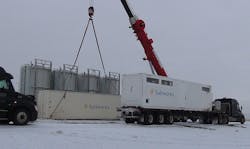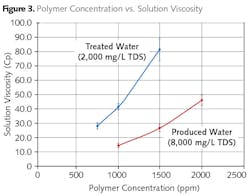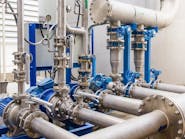Produced Water Treatment Pilot Shows Promise
By Adrian Ebsary
A recent produced water treatment pilot test for enhanced oil recovery (EOR) polymer waterflooding suggests that operators could save 50 percent on polymer costs. The technology that enabled these results was a next generation electrodialysis reversal (EDR) system produced and operated by Saltworks Technologies. The system, called Flex EDR, employs Saltworks’ proprietary ion exchange membranes, which withstand harsh produced water operating conditions. The results offer oil companies new opportunities to recover more oil and keep aging reservoirs running profitably for longer.
Treating Produced Water for Reinjection
Waterflooding as a technique for improving oil recovery has been used since the 1940s and has undergone many innovations over the years. The most basic waterfloods involve injecting water into an oil-bearing formation to push out more oil; however, the water returns as produced water and has often picked up salt on its journey through the formation. As reservoir operators recycle produced water and experiment with ways to improve oil recovery, two major trends have emerged. First, injection waters with lower concentrations of salt, particularly calcium and magnesium (hardness), have been shown to increase oil yield in certain reservoirs. Second, adding special polymers to a waterflood increases injected water viscosity, acting as a hydraulic ‘piston’ to push out more oil. Together, these factors can improve the sweep of a waterflood, which increases the amount of oil that reaches the surface.
Figure 1. A diagram depicting a simplified EDR system setup (left) and a full scale EDR stack (right). These pilot results have further applications outside EOR, where high organic fouling potential or solvent degradation of membranes are a concern. For example, the same pilot plant was used to lower salt load at a chemical production facility with wastewater that was not suitable for RO treatment.
It has been shown that EOR can recover up to 40 percent more oil from a surface-based or off-shore oil production facility. This extends the life and maximizes productivity of existing assets, while also reducing environmental impact. Produced water treatment in EOR is an example where water investments can be a profit center rather than a cost center.
In some oil reservoirs, lower salinity injection water may assist in recovering additional oil; however, this work focuses on the clear business case for EOR polymer floods. This is because operators shoulder significant recurring polymer consumption costs. For example, a 1,000 to 4,000 m3/day injection site might consume anywhere between $2M to $10M USD in polymer per year. The amount of polymer consumed increases with salinity, so more salty water leads to greater chemical costs. In addition, the pilot data demonstrates that desalting can reactivate polymer present in the produced water, as long as it is not sheared or damaged. Therefore, two cost savings result from desalting: reusing some of the existing polymer and substantially reducing the make-up polymer that must be added. Produced water treatment also lowers other costs by reducing wastewater disposal and make-up water extraction.
Figure 2. The Flex EDR plant being installed at the EOR site in Alberta.
Although the most economic and widely used desalination treatment system on the market is reverse osmosis (RO), it cannot stand up to the harsh organics and solvents present in produced water without extensive pretreatment. RO membranes can foul or swell in the presence of hydrocarbons, rendering them non-functional. Evaporation systems are better suited to handle produced water, yet the substantial five- to ten-fold jump in total cost of ownership compared to membrane systems discourages most operators from going in this direction. Instead, most EOR operators will choose to either keep adding polymer, send their produced water to disposal wells, find another source of freshwater with lower salinity, or some combination of these three options.
However, a recent pilot offers another option with compelling economics, proven out in an Albertan polymer flood oil field. This system enables the use of a lower-cost and more energy-efficient membrane system, with minimal pretreatment and maximum recycling of produced water, while also achieving the benefits of lower salinity.
This new option for produced water treatment leverages EDR, the second most widely used membrane desalination technology. EDR avoids the use of pressurized water transport through a membrane. Instead, a voltage is applied to extract salt ions across ion exchange membranes, which reduces organic fouling risk. However, until recently, there was no way to prevent hydrocarbon and solvent damage to the membranes. An ion exchange membrane, developed by Saltworks from highly cross-linked polymers that are unimpacted by hydrocarbons and solvents, enables produced water desalination without extensive pretreatment.
The EOR Pilot Project Setup
The development team installed a mobile EDR treatment plant in an operating polymer flood oil field as part of a project that was supported with funding from Alberta Innovates and Sustainable Technology Development Canada. The plant continuously treated produced water with variable salinity, oil-in-water and organics over a 60-day period, including unattended overnight operation. It desalted to three target salinity levels optimized for polymer consumption, after which the desalted water was used in live polymer flood injection trials. Polymer savings varied from 40 to 60 percent depending on the application and measurement, representing millions of dollars a year in OpEx savings and up to a 30 percent return on investment for the desalination unit capital and operating cost. When accounting for the reduced disposal and freshwater withdraw, the return on investment increases. Water recovery was consistently 90 percent and resulted in the removal of almost all calcium, magnesium, barium and strontium, which can provide further benefits by reducing oil wettability in the reservoir.
Figure 3. A graphic depicting the relationship between polymer concentration and solution viscosity for two solutions: the higher salinity produced water and the lower salinity water treated by Saltworks’ Flex EDR.
EDR Treated Produced Water Reinjection Economics
The strongest case for making water treatment a profit center in EOR lies in reducing polymer consumption. For example, achieving a set viscosity of 46 centipoise (cP) required a polymer concentration of 2,000 ppm with produced water containing 8,000 mg TDS of salinity, whereas the lower salinity treated water (2,000 mg/L TDS) required half the concentration of polymer, around 1,000 ppm.
Although the precise quantity of cost savings on polymer consumption will vary depending on target salinity and the unique properties of each reservoir, the development team’s data from the pilot suggests that a reduction in polymer costs of approximately 50 percent is possible for polymer flood sites with TDS up to 25,000 mg/L. IWW
Adrian Ebsary is the director of marketing for Saltworks Technology. He works closely with the technical teams at Saltworks to share the company’s expertise and innovative water treatment solutions with organizations across a wide range of industries. He holds a BSc. in biochemistry and has extensive experience driving business-to-business growth in the technology sector.
Circle No. 143 on Reader Service Card





